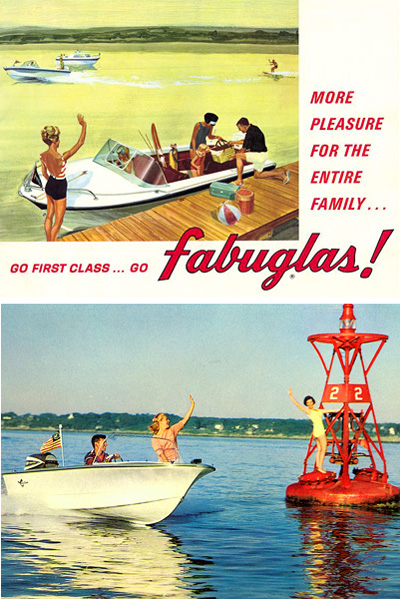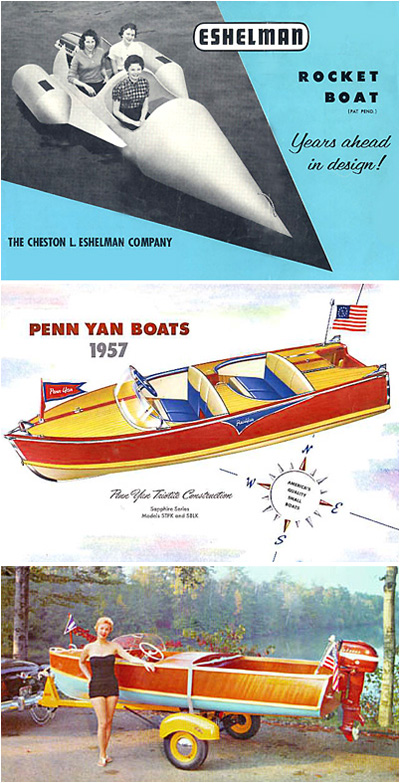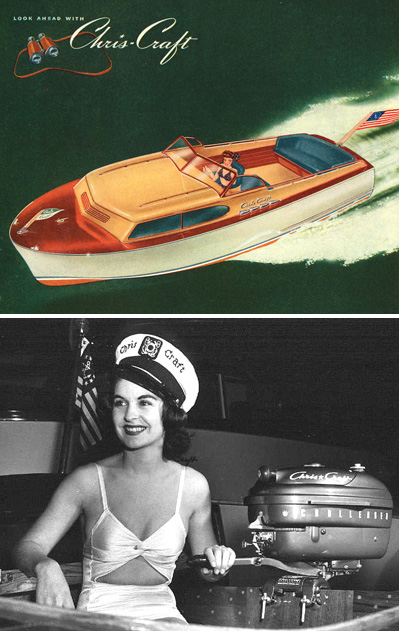When I was four or five, my father decided to build a small speedboat in his garage, a culmination of his interests in woodworking, fishing, and one-upping the neighbors. Owning a recreational boat in the mid-1960s was all the rage — a symbol of freedom, prosperity, and individuality. In the boating magazines my father embraced, I saw nothing but happy families out for a good time, gliding over the waves with hands outstretched, waving to whoever might be jealously watching from shore. And for several years that’s what having a boat meant to me.

The Fabuglas line of boats promised more pleasure in 1969 (top), and the 63 Crestliner catalog shows once again the importance of getting down the “wave.”
I’m not sure that recreational boating can be described as a genre with its own art style, but it has always felt unique to me. Perhaps it’s because boats are a little like cats — you either like them or you hate them. And that determines, to a large degree, your interest in boating-related activities like fishing, water skiing, swimming, and drinking excessively. Although I never had much attraction to those things, going boating was a time to be with my father, and it was usually how we spent our summer vacation, so I went along with the program. But I think for both my dad and me the main benefits of owning a boat were the “men things,” such as keeping the motor running, mixing the two-stroke engine fuel, working the winch on the trailer, and cussing when things didn’t go right.

Johnson Outboard Motors featured push-button starters (top) and in 1962 Spartan Trailers used stylized art to promote the pleasure of boating (bottom).
Boat Dollars
Boat ads have always had to cover two distinct targets — the men who want them, and the women who have to say it’s okay to buy them. I once read that in the average household, each spouse is typically comfortable spending up to only $100 without getting the other spouse’s approval. Even in my dad’s day of $5,000-a-year salaries, buying or building a boat fell into the over-$100 equivalent category.

In 1963 you could fall in love next to your Crestliner (top) or quickly get to your island wedding (bottom) with a Starchief V.

Mercury Motors featured these skiers from Cypress Gardens in Florida in its ads from 1954.
Typically ads for the boats themselves show attractive couples doing things together, and are clearly designed to prove that the acquisition of a boat is not at all about the man’s desire to drive as fast as possible, but about the family’s diverse recreational needs. From the looks of many boat brochures, I suspect the decision to purchase a boat is based on how well the buyers think they look in a bathing suit. That wasn’t a problem in my family. Both my mother and father approached the outdoors like hazardous waste — they covered up with layered clothing, hats, sunglasses, umbrellas, and whatever else would shield them from the harmful rays of the sun, or the preying eyes of others. As a family we didn’t exactly have what you would describe as positive body images, but we did know how to wave enthusiastically nonetheless.

The Cheston L. Eshelman Company of Baltimore made airplanes, garden carts and, briefly, rocket boats (top). Penn Yan classic wood boats (center) were made in New York, and a 1956 Tee Nee Trailer is pictured with a Whirlwind Deluxe molded-plywood beauty (bottom).

Christpher Columbus Smith built his first boat in 1874 at the age of 13, and he went on to found one of the most influential small boat companies in America: the Chris-Craft Corporation. Chris-Craft models were popular among the stars and are still on the seas today. Above, a 23-foot Chris-Craft Express Cruiser in 1945, and below, a spokes-model unveiling a new design at a boat show. Chris-Craft was famous for the stylized artwork used in its advertising.
When it came to advertising outboard motors, manufacturers figured the target was almost exclusively the man. Thus we see an emphasis on performance, power, and size, along with a good dose of scantily clad models standing by the motors for comparison. Outboard motors represent to me one of the finest of all mechanical design categories, and were it not for a lack of space I would probably have a rusting pile of them somewhere in my yard.

“For the man who wants to be king…” read the ad for the 40hp RoyalScott outboard motor (top). At Sears (below) charming models showed off the new Elgin engines in 1959.
I grew up in Baltimore, and by the time I was 11, Mom decided it would be a good idea for me to go somewhere during the summers (reasoning that the city was stiflingly hot and besides, things like horseback riding and wilderness hiking are good for building character). So for six years I traveled to summer camp in the mountains that separated Maryland and West Virginia. My first summer I played Alice in the summer camp production of Alice in Wonderland (the apex of my stage career), I had my first boyfriend in summer camp, rappelled down my first cliff, took my first white water rafting trip. Mom was right: Summer camp did build character.
Of course, that character went into recession in my teenage years, when hanging out in parking lots drinking purloined peach schnapps began to seem like more fun than singing songs around the campfire. So I stopped getting on the charter bus every June, and summer camp began to fade away. All of the campers and counselors I met over my six-summer tour were left behind. After the first few years I forgot about most of them. I never actually expected to see them again. But now, thanks to the Internet, it looks as if I will.
Instant Reunion
Last week I got a call from an old camp counselor. It took me a while to place his name. It seems he’d heard my name on the local NPR station (I work two days a week helping to produce a public affairs show) and figured there couldn’t be so many Andrea Dudrows in the world. He was right. He got my e-mail address and signed me up for Yahoo! Groups, where my old summer camp has set up a virtual meeting corner. I spent the better part of a day reading messages from past summer camp cronies and browsing pictures of a recent reunion, matching the old names to the changed faces (some changed more than others).
As interesting as it was to see how 15 years rests on various faces, what I found most interesting was that I was seeing it at all. Back in 1986, there was no Internet and there was no Yahoo!. And I can’t help but wonder if my re-introduction to a world I’d left far behind would have happened without the cooperation between these two entities.
The Übersite
Yahoo has cornered the market on dot-com business plans. Think about it: Pretty much any idea that’s gotten venture capital funding in the past three years has a counterpart on Yahoo!. Yahoo! Auctions. Yahoo! Invites. Yahoo! Games. Yahoo! News. Yahoo! Personals. Yahoo! Careers. Yahoo! Finance. Not to mention Yahoo! Groups, Yahoo! Clubs, and Yahoo! e-mail. Yahoo! may be a portal site, but it’s a portal mainly to itself. It’s like a latter day America Online. Except free. For more and more people, Yahoo! is the Internet.
My friend Roger has a Yahoo! e-mail account. He has all of his friends’ e-mail addresses stored in a Yahoo! address book. He organizes his weekly poker night with the boys using a Yahoo! Club (don’t worry, they play for Necco wafers, not cash). He has a personalized Yahoo! home page (you can get a Badtz Maru design scheme). He gets his news (at least his online news) from Yahoo!. And of course it’s all free.
Roger and I sometimes talk about what would happen if Yahoo! decided to start charging for its services (and the company could use the extra income right about now, as it’s proving that it’s not immune to the dot-economy slump). At this point, when consumers are used to the idea of a largely free Web, implementing a fee system might chase away a good portion of Yahoo!’s membership, but a pay service could be just the thing for the future. Especially with so many Yahoo! users signed up for so many different Yahoo! services.
Spreading Itself Thin Works
It looks as if trying to be all things to all people is working for Yahoo! as much as it isn’t working for sites like Amazon. Though it may just be reaping the benefits of having been there first, I’m willing to bet that Yahoo! will be one of the only major dot-coms to survive the economic downturn. And it will do this by being the every-dot-com. That is, by putting every dot-com business plan and every Web-based service idea into practice, not just one.
Personally, I know I will be spending much more time on Yahoo! from now on, looking at photos of my old summer camp cabins and the friends I’d made, and forgotten.


